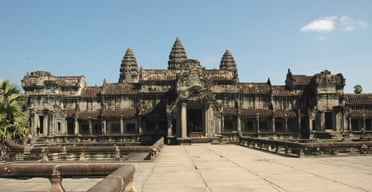It has survived the collapse of the sophisticated civilisation that built it, centuries of consumption by the suffocating jungle and the nihilism of the Khmer Rouge, who beheaded its stone Buddhas and used its walls for target practice. Now, Cambodia's awe-inspiring Angkor Wat complex is facing the biggest threat in a millennium - the fastest-growing tourist onslaught of any World Heritage site, which conservationists warn is already damaging its treasures irreparably.
In 1993, after Angkor was added to Unesco's World Heritage List, just 7,650 intrepid visitors ventured to the site. Last year Sokimex, the oil company controversially granted the entrance concession on behalf of the government's Apsara Angkor management, sold almost 900,000 tickets worth $25m (£12.8m), with British travellers making up the fourth biggest contingent behind South Koreans, Japanese and North Americans. Three million visitors are expected in 2010.
Teruo Jinnai, Unesco's top official at Angkor, said: 'We are very concerned by this unprecedented, uncontrolled acceleration, which is damaging the monuments and the local environment. Preservation of the park for future generations has to be the number one priority, over and above commercial exploitation, which is mainly benefiting foreign interests instead of the local population.' Kerya Chau Sun, director of tourism at Angkor, said: 'We are finalising regulations for controlling visitors. We will train guards to watch the temples and educate visitors to help us protect the monuments.'
However, John Stubbs, who has spent 15 years working at Angkor with the New York-based World Monuments Fund, said: 'Tourism is already out of control, and unless the Cambodian government takes some pretty radical action to rein it in now much of Angkor's magic and heritage could be lost forever.' The five-tiered Phnom Bakheng hilltop temple, one of the most significant relics of the ancient Khmer civilisation, is one of the most endangered of the park's 40-plus monuments. More than 3,000 tourists clamber up its narrow stone staircases every evening, manhandling sandstone carvings as they jostle for a sunset view of Angkor Wat, the world's biggest religious structure. Stubbs said: 'It simply cannot survive this daily assault. Unless it is completely closed off for essential repairs, Phnom Bakheng will suffer critical damage.'
The World Bank warns that other temples, including the spectacular Bayon with four-faced Buddhas carved on its 54 towers, are sinking into their sandy foundations as the hospitality industry drains underground water reservoirs.
Meanwhile, the site's serenity is being overwhelmed by crass commercialisation, from the Las Vegas-style shopping malls in the mushrooming town, Siem Reap, to a gaudy Angkor theme park just outside the complex. In May a Nick Faldo-designed golf course opens, the second water-guzzling 18-holer to be built in two years within four miles of the park. And the area's water supplies are being polluted by hotels flushing untreated sewage into the flood-prone Siem Reap river.
So can the well-meaning traveller experience the splendours of Angkor without contributing to its decline? Jarrod Kyte, UK manager of Gecko's Adventures, which offers an eco-tour helping clean up rubbish at the site, said: 'We train local guides to make sure our clients know exactly how to dress and behave and we use locally owned restaurants and hotels.'
Sam Morton, 40, from Brighton, planned to stay in Siem Reap for five days - but stayed on to work with deprived children at the Volunteer Development Poverty Children School run by two young Buddhist monks. She said: 'Working in the school was incredibly rewarding and I at least felt I was giving something back.' The director and co-founder of the school, the Venerable Nn Rathana, said: 'By just taking one afternoon to volunteer and make a small donation, foreigners can make a real difference.'
